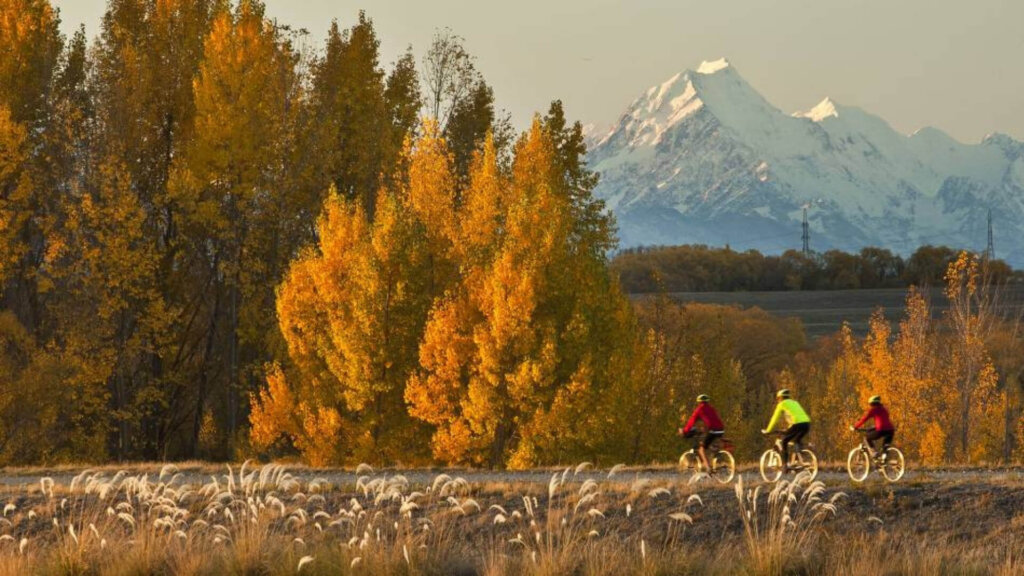Discover the Best Time to Visit New Zealand: Seasons and Tips

When planning your trip to New Zealand, pinpointing the best time to visit New Zealand is essential. The timing of your visit can transform your experience, given how dramatically the weather and activities shift throughout the year. By grasping the seasonal patterns and highlights, you can optimize your adventure. Whether you’re eager to explore lush hiking trails, dive into exciting water sports, or soak up the vibrant atmosphere of local festivals. Understanding these nuances ensures your trip aligns perfectly with your interests, making every moment unforgettable.
I. Understanding New Zealand’s Seasons
1. Summer (December to February)
During summer, temperatures in New Zealand typically range from 20°C to 30°C (68°F to 86°F). The North Island generally experiences warmer temperatures compared to the South Island.
Expect long, sunny days with occasional rain showers, particularly on the West Coast of the South Island. Humidity levels can be moderate to high, making the heat feel more intense.

Summer is the prime time for beach outings, hiking, and exploring New Zealand’s stunning landscapes. Key activities include:
- Surfing in the Bay of Plenty.
- Trekking the Tongariro Alpine Crossing.
- Kayaking in the Abel Tasman National Park.
The warm weather also makes it ideal for outdoor dining and enjoying New Zealand’s diverse flora and fauna.
Summer is a good time to visit New Zealand, as it is filled with festivals and events. The Wellington Sevens, a popular rugby tournament, draws large crowds with its festive atmosphere and entertainment. Music festivals like Rhythm and Vines provide live performances and a vibrant party scene. New Year’s Eve celebrations in major cities are lively, featuring fireworks and public festivities.
2. Autumn (March to May)
Autumn temperatures in New Zealand typically range from 10°C to 20°C (50°F to 68°F). The weather starts cooler than summer, with temperatures gradually decreasing as the season progresses.
Expect crisp, cool days with decreasing daylight hours. Rainfall becomes more frequent, especially in the western regions. Early autumn may feel mild, but temperatures can drop significantly by late May.

Autumn is ideal for scenic drives and outdoor activities as the landscape transforms into a tapestry of vibrant fall colors. Popular activities include wine-tasting tours in regions like Central Otago, hiking in the Southern Alps, and exploring the changing foliage in national parks such as Fiordland and Tongariro.
Autumn is rich with cultural and food festivals. The Christchurch Arts Festival and the Auckland Lantern Festival celebrate the season with artistic performances and displays. Food festivals like the Marlborough Wine and Food Festival highlight local produce and wine, making it an excellent time for culinary enthusiasts.
3. Winter (June to August)
Winter temperatures in New Zealand vary significantly between the North and South Islands. In the South Island, temperatures typically range from 0°C to 15°C (32°F to 59°F), with colder conditions in mountainous areas. The North Island experiences milder temperatures, ranging from 5°C to 16°C (41°F to 61°F).
Expect cold and often frosty conditions, with snow common in higher altitudes, particularly in the Southern Alps. Rainfall is frequent, especially in the western regions. While the South Island sees more snow, the North Island generally experiences more excellent, damp conditions.

Winter is the peak season for snow sports. Queenstown, Wanaka, and the Southern Alps offer premier skiing and snowboarding opportunities. The season is also ideal for exploring geothermal areas like Rotorua, where the contrast of hot springs against cold weather is particularly striking. Additionally, winter hiking and scenic drives provide unique views of snow-covered landscapes.
Winter brings several exciting events. The Queenstown Winter Festival features music, comedy, and snow sports. The Winter Games NZ, held in various locations, showcases international and local talent in skiing and snowboarding. Various local festivals and markets offer cozy atmospheres and seasonal foods.
4. Spring (September to November)
During spring, temperatures in New Zealand typically range from 10°C to 20°C (50°F to 68°F). The weather begins to warm up, though early spring can still be quite cool, especially in the southern regions.
Spring features gradually increasing temperatures and longer daylight hours. The weather is generally mild, with occasional rain showers contributing to lush landscapes and blooming flora. Early spring can still experience some residual cold spells, but temperatures are comfortably warm by November.

Spring is widely regarded as the best time to visit New Zealand for outdoor adventures, as the landscape bursts into vibrant color. This season is ideal for hiking in national parks like Fiordland and Abel Tasman, cycling along scenic routes, and exploring beautifully blooming gardens. Additionally, spring offers excellent opportunities for wildlife spotting, with many bird species and marine life becoming more active.
Spring hosts several vibrant festivals. The Auckland Arts Festival showcases a range of artistic performances and cultural events. The Wellington Spring Festival celebrates the season with markets, food, and live entertainment. Additionally, garden shows and flower festivals across the country highlight the season’s natural beauty.
II. Best Time for Specific Activities in New Zealand
New Zealand offers a variety of activities throughout the year, each best enjoyed during specific times. Whether you’re an adventure seeker, nature enthusiast, or culture lover, knowing the best time of year to visit New Zealand for different activities can help you plan an unforgettable trip. This guide highlights the optimal times to experience mountain climbing, skiing, whale watching, wine tasting, and Maori culture.
1. Mountain Climbing and Hiking
Best Times: Summer and Autumn
Summer (December to February): Summer is the prime time and best time to visit New Zealand for mountain climbing and hiking. The warm weather and extended daylight make it ideal for tackling some of the country’s most famous trails. Popular hikes such as the Tongariro Alpine Crossing and the Routeburn Track are best explored during these months. The clear skies and stable weather conditions enhance the experience, offering breathtaking views and more comfortable climbing conditions.

Autumn (March to May): Autumn is regarded as the best time to visit New Zealand for hiking. The cooler temperatures make trekking more comfortable, while the changing foliage provides a stunning backdrop of colors. Trails such as the Hooker Valley Track and the Ben Lomond Track are particularly beautiful during this season, with fewer crowds and crisp, fresh air making for an enhanced outdoor adventure.
2. Skiing and Snowboarding
Best Time: Winter (June to August)

Winter (June to August): Winter is the best time to visit New Zealand for skiing and snowboarding. The country’s ski resorts, such as Queenstown’s Remarkables and Coronet Peak, Wanaka’s Cardrona and Treble Cone, and Mount Ruapehu’s Whakapapa and Turoa, offer excellent snow conditions and a range of runs suitable for all levels. The winter months provide the best snow coverage, allowing you to enjoy a variety of winter sports in stunning alpine settings.
3. Whale Watching
Best Times: Winter and Spring
Winter (June to August): Winter is widely regarded as the best time to visit New Zealand for whale watching. During this season, humpback whales migrate from their feeding grounds in Antarctica to the warmer breeding waters around New Zealand. Kaikoura is a premier destination for whale watching at this time, providing an exceptional opportunity to observe these majestic creatures up close in nutrient-rich waters.

Spring (September to November): Spring is the best time to visit New Zealand for whale watching, with the added bonus of spotting orcas and sperm whales. The warmer weather and calmer seas create ideal viewing conditions, particularly in regions like the Bay of Islands, where you can enjoy both whale and dolphin encounters.
4. Wine Tasting
Best Time: Autumn (March to May)

Autumn (March to May): Autumn is considered the best time to visit New Zealand for wine tasting. This season coincides with the harvest, when vineyards are bustling with activity and the grapes are at their peak. Renowned regions such as Marlborough, Hawke’s Bay, and Central Otago offer exceptional wine tours and tastings. The cooler weather and vibrant autumnal colors further enhance the experience, making it an ideal time to explore the wine country and savor a variety of locally produced wines.
5. Experiencing Maori Culture
Best Time: Year-Round

Year-Round: Experiencing Maori culture is a New Zealand must visit and can be enjoyed throughout the year. New Zealand’s rich Maori heritage is celebrated annually with various events, performances, and cultural activities. Visitors can explore traditional Maori villages, attend cultural festivals, and participate in ceremonies and storytelling sessions. Significant cultural experiences include visiting the Waitangi Treaty Grounds and attending the annual Te Matatini festival, showcasing Maori performing arts.
III. Planning Your Visit: Tips and Recommendations
Planning a trip to New Zealand involves several key considerations to ensure a smooth and memorable experience. Understanding the best time to visit New Zealand, along with booking flights and accommodation, managing seasonal price fluctuations, and packing appropriately, is crucial. This guide offers essential tips and recommendations to help you maximize your visit and enjoy everything New Zealand has to offer.
1. Booking Flights and Accommodation
Booking Flights
Book Early: Book your flights for at least three to six months to secure the best deals and availability. Early booking helps avoid last-minute price hikes and ensures you get your preferred flight times.

Compare Prices: Use flight comparison websites to find the best rates. Comparing prices across airlines and booking platforms can help you identify the most cost-effective options.
Consider Flexibility: Being flexible with travel dates can result in significant savings. Mid-week flights or traveling during off-peak times, such as outside school holidays or major public holidays, often offer lower fares.
Check for Deals: Look for special promotions or deals from airlines. Signing up for fare alerts and newsletters can help you stay informed about discounts and special offers.
Booking Accommodation
Choose Based on Your Itinerary: Select Accommodation that aligns with your travel plans and destinations. If you plan to explore various regions, consider booking stays in critical locations like Auckland, Queenstown, and Rotorua to minimize travel time.
Book in Advance: Similar to flights, booking Accommodation early can provide better options and rates. Waiting too long can lead to higher prices and limited availability in popular areas and peak travel seasons.
Consider Different Types of Accommodation: New Zealand offers many lodging options, including hotels, motels, hostels, and holiday parks. Choose based on your budget, preferences, and the amenities you require.
Read Reviews: Before making a reservation, read reviews from previous guests to gauge the quality and suitability of the Accommodation. This can provide insights into the location, service, and overall experience.
2. Packing Tips
Essential Items
Travel Documents: Ensure you have all necessary documents, including your passport, visa (if required), and travel insurance. As a precaution, keep copies of these documents in a separate location.
Adapters and Chargers: New Zealand uses Type I electrical plugs. Bring appropriate adapters and chargers for your electronic devices to ensure you can power them during your stay.
Clothing

Layering: New Zealand’s weather can be variable, so packing layers is essential. Include base layers, insulating layers, and a waterproof outer layer to adapt to changing conditions.
Comfortable Footwear: Bring comfortable and durable shoes, especially if you plan to hike or explore outdoor areas. Good walking shoes are also important for city tours and general sightseeing.
Seasonal Clothing: Pack clothing appropriate for the season you’re visiting:
- Summer (December to February): Lightweight and breathable clothing, swimwear, and sun protection items like hats and sunscreen.
- Autumn (March to May): Wear layered clothing, including a light jacket and comfortable shoes, to walk through colorful autumn landscapes.
- Winter (June to August): If you’re heading to ski resorts, wear warm clothing, such as a heavy coat, thermal layers, and waterproof gear.
- Spring (September to November): Versatile layers to handle fluctuating temperatures and a rain jacket for spring showers.
For detailed guidance on suitable attire across seasons and regions, check out our guide on What to Wear in New Zealand.
And, have a nice trip to New Zealand!
Choosing the best time to visit New Zealand depends on your interests and what you want to experience. Whether you’re drawn to outdoor adventures, wildlife viewing, or cultural festivals, New Zealand offers something for every season. By understanding the seasonal variations and planning accordingly, you can ensure a memorable and enjoyable trip.
FAQs
What is the best time for a budget traveler to visit New Zealand?
The spring and autumn shoulder seasons are considered the best time to visit New Zealand for better rates on flights and accommodation compared to the peak summer or winter seasons.
Are there any specific events or festivals I shouldn’t miss?
Significant events like the Wellington Sevens, the Auckland Arts Festival, and the Queenstown Winter Festival are notable—research specific dates and events based on your interests.
How does the weather in New Zealand affect travel plans?
Weather can be unpredictable, so it’s important to plan activities according to seasonal weather patterns and be prepared for sudden changes.
What are the top hiking trails in New Zealand for each season?
In summer, trails like the Tongariro Alpine Crossing are ideal. The Routeburn and Milford Tracks offer stunning scenery in autumn and spring with fewer crowds.
When is the best time to go whale watching in New Zealand?
Whale watching is considered the best time to visit New Zealand from June to August, when humpback whales migrate through New Zealand waters.

I am Leilani Miller – I research focusing on Vanuatu – volcanic landscapes, blue holes, coral reefs & rainforests. I have over five years of experience researching and sharing insights on tourism and environmental activism. Explore and experience without limits through my latest article.
Contact information:
Email: [email protected]
Tel: +1 (808) 555-1528






